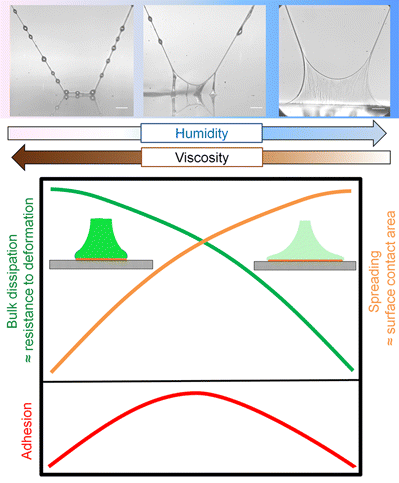Spider webs are notoriously sticky. Although they only take a second to swat down, shaking them off your hands can be an exercise in frustration. But that stubborn tackiness could come in handy when designing smart synthetic adhesives that could work even in the most humid conditions. In the journal ACS Nano, scientists report new insight toward that goal.
From parched deserts to the dampest rainforests, spiders have adapted to a wide range of habitats. No matter where they live, the glue on their webs efficiently traps prey. Synthetic glues, on the other hand, tend to lose stickiness as humidity rises. Just try putting on a bandage right after a hot shower—it won't stay put for long. So in a search for ways to make better adhesives, scientists have turned to glues that spiders use to coat their silk strands. Some of the key ingredients of these glues are salts that hold onto water and change the viscosity—or how much a substance can spread—and, as a result, the stickiness. A team of material scientists and biologists at Virginia Tech and the University of Akron in Ohio, including Ali Dhinojwala and doctoral student Gaurav Amarpuri, wanted to see—literally—how different spider glues' viscosity and tackiness change at different humidity levels.
The researchers shot high-speed video of five different web glues as they peeled away from a surface under varying moisture levels to understand the role humidity plays in web gooeyness and adherence. In the humidity range matching that of the natural habitat of the species that made each sample, viscosity was at an optimal level, and stickiness peaked. As salts are the key ingredient that controls for moisture, the researchers say adding them to synthetic adhesives could help keep them clingy even in high humidity.
More information: Gaurav Amarpuri et al. Spiders Tune Glue Viscosity to Maximize Adhesion, ACS Nano (2015). DOI: 10.1021/acsnano.5b05658
Abstract
Adhesion in humid conditions is a fundamental challenge to both natural and synthetic adhesives. Yet, glue from most spider species becomes stickier as humidity increases. We find the adhesion of spider glue, from five diverse spider species, maximizes at very different humidities that matches their foraging habitats. By using high-speed imaging and spreading power law, we find that the glue viscosity varies over 5 orders of magnitude with humidity for each species, yet the viscosity at maximal adhesion for each species is nearly identical, 105–106 cP. Many natural systems take advantage of viscosity to improve functional response, but spider glue's humidity responsiveness is a novel adaptation that makes the glue stickiest in each species' preferred habitat. This tuning is achieved by a combination of proteins and hygroscopic organic salts that determines water uptake in the glue. We therefore anticipate that manipulation of polymer–salts interaction to control viscosity can provide a simple mechanism to design humidity responsive smart adhesives.
Journal information: ACS Nano
Provided by American Chemical Society
























